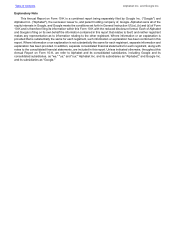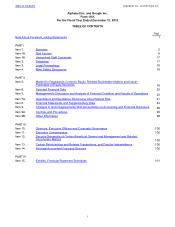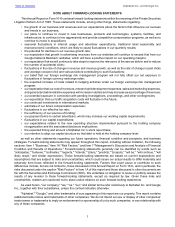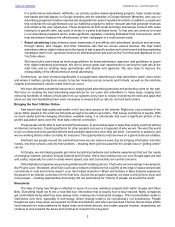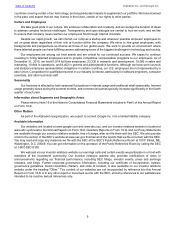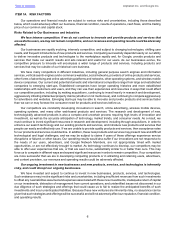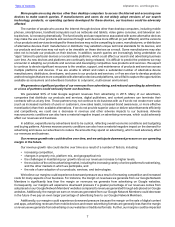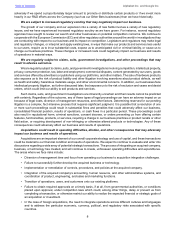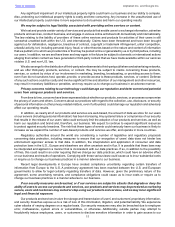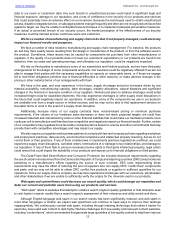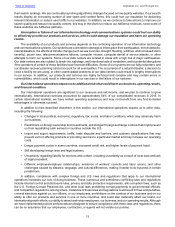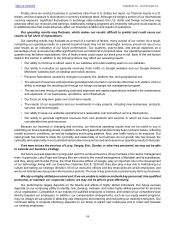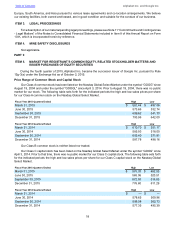Google 2015 Annual Report Download - page 12
Download and view the complete annual report
Please find page 12 of the 2015 Google annual report below. You can navigate through the pages in the report by either clicking on the pages listed below, or by using the keyword search tool below to find specific information within the annual report.
Table of Contents Alphabet Inc. and Google Inc.
8
adversely if we spend a proportionately larger amount to promote or distribute certain products or if we invest more
heavily in our R&D efforts across the Company (such as our Other Bets businesses) than we have historically.
We are subject to increased regulatory scrutiny that may negatively impact our business.
The growth of our company and our expansion into a variety of new fields involves a variety of new regulatory
issues, and we have experienced increased regulatory scrutiny as we have grown. For instance, several regulatory
agencies have sought to review our search and other businesses on potential competition concerns. We continue to
cooperate with the European Commission (EC) and other regulatory authorities around the world in investigations they
are conducting with respect to our business and its impact on competition. Legislators and regulators may make legal
and regulatory changes, or interpret and apply existing laws, in ways that make our products and services less useful
to our users, require us to incur substantial costs, expose us to unanticipated civil or criminal liability, or cause us to
change our business practices. These changes or increased costs could negatively impact our business and results
of operations in material ways.
We are regularly subject to claims, suits, government investigations, and other proceedings that may
result in adverse outcomes.
We are regularly subject to claims, suits, and government investigations involving competition, intellectual property,
privacy, consumer protection, tax, labor and employment, commercial disputes, content generated by our users, goods
and services offered by advertisers or publishers using our platforms, and other matters. The sale of hardware products
also exposes us to the risk of product liability and other litigation involving assertions about product defects, as well
as health and safety, hazardous materials usage, and other environmental concerns. In addition, our businesses face
intellectual property litigation, as further discussed later, that exposes us to the risk of exclusion and cease and desist
orders, which could limit our ability to sell products and services.
Such claims, suits, and government investigations are inherently uncertain and their results cannot be predicted
with certainty. Regardless of the outcome, any of these types of legal proceedings can have an adverse impact on us
because of legal costs, diversion of management resources, and other factors. Determining reserves for our pending
litigation is a complex, fact-intensive process that requires significant judgment. It is possible that a resolution of one
or more such proceedings could result in substantial fines and penalties that could adversely affect our business,
consolidated financial position, results of operations, or cash flows in a particular period. These proceedings could
also result in reputational harm, criminal sanctions, consent decrees, or orders preventing us from offering certain
features, functionalities, products, or services, requiring a change in our business practices or product recalls or other
field action, or requiring development of non-infringing or otherwise altered products or technologies. Any of these
consequences could adversely affect our business and results of operations.
Acquisitions could result in operating difficulties, dilution, and other consequences that may adversely
impact our business and results of operations.
Acquisitions are an important element of our overall corporate strategy and use of capital, and these transactions
could be material to our financial condition and results of operations. We expect to continue to evaluate and enter into
discussions regarding a wide array of potential strategic transactions. The process of integrating an acquired company,
business, or technology has created, and will continue to create, unforeseen operating difficulties and expenditures.
The areas where we face risks include:
• Diversion of management time and focus from operating our business to acquisition integration challenges.
• Failure to successfully further develop the acquired business or technology.
• Implementation or remediation of controls, procedures, and policies at the acquired company.
• Integration of the acquired company's accounting, human resource, and other administrative systems, and
coordination of product, engineering, and sales and marketing functions.
• Transition of operations, users, and customers onto our existing platforms.
• Failure to obtain required approvals on a timely basis, if at all, from governmental authorities, or conditions
placed upon approval, under competition laws which could, among other things, delay or prevent us from
completing a transaction, or otherwise restrict our ability to realize the expected financial or strategic goals of
an acquisition or investment.
• In the case of foreign acquisitions, the need to integrate operations across different cultures and languages
and to address the particular economic, currency, political, and regulatory risks associated with specific
countries.



